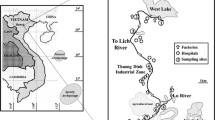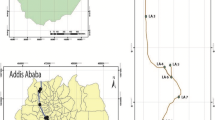Abstract
Concentrations of major and trace elements (Al, Fe, Mn, B, Cd, Co, Cr, Cu, Mo, Ni, Pb, Sr, V, and Zn) were determined in water and sediments from irrigation canals and the Nile River in an agricultural area of 120 km2 to evaluate the impact of agricultural practices and the spatial distribution and mobility of these elements. The enrichment factors of cadmium indicate contamination in this area. Metal pollution indices are higher at locations downstream of the irrigation canals, possibly a consequence of waste discharges and phosphate fertilizing. Comparisons with consensus-based sediment quality guidelines revealed that ∼92 % (Cr), ∼85 % (Cu), ∼46 % (Ni), and ∼23 % (Zn) of the samples exceeded the threshold effect concentrations, with 7.7 % for Cr and Ni being above the probable effect concentration. Contamination with many metals in water was found in the secondary irrigation canals. The partition coefficients of all determined metals were evaluated. The major elements Al, Fe, and Mn were found to be very mobile while V was the least mobile.




Similar content being viewed by others
References
Allen, S. E. (1989). Chemical analysis of ecological materials (2nd ed.). Oxford: Blackwell Scientific Publication.
Anbar, A. D., & Rouxel, O. (2007). Metal Stable isotopes in paleoceanography. Annual Review of Earth and Planetary Sciences, 34, 717–746.
Chetelat, B., & Gaillardet, J. (2005). Boron isotopes in the seine river, France: a probe of anthropogenic contamination. Environmental Science & Technology, 39, 2486–2493.
Dai, J., Song, J., Li, X., Yuan, H., Li, N., & Zheng, G. (2007). “Environmental changes reflected by sedimentary geochemistry in recent hundred years of Jiaozhou Bay, North China”. Environmental Pollution, 145, 656–667.
DiToro, D. M., Mahony, J. D., Hansen, D. J., Scott, K. J., Hicks, M. E., Mays, S. M., & Redmont, M. S. (1990). Toxicity of cadmium in sediments: the role of acid volatile sulphides. Environmental Toxicology and Chemistry, 9, 1487–1502.
Farkas, A., Erratico, C., & Vigan, L. (2007). “Assessment of the environmental significance of heavy metal pollution in surficial sediments of the River Po”. Chemosphere, 68, 761–768.
Hakanson, L. (1980). “An ecological risk index for aquatic pollution control. A sedimentological approach”. Water Research, 14, 975–1001.
Harikumar, P. S., Nasir, U. P., & Mujeebu, M. P. (2009). “Distribution of heavy metals in the core sediments of a tropical wetland system”. International Journal of Environmental Science and Technology, 6, 225–232.
Kumar, G. P. (2008). “Growth of Jatrophacurcas on heavy metal contaminated soil amended with industrial wastes and Azotobacter – a greenhouse study”. Bioresource Technolology, 99, 2078–2082.
Kumar, S. P., & Edward, J. K. P. (2009). “Assessment of metal concentration in the sediment core of Manakudy estuary of south west coast of India”. Indian Journal of Marine Sciences, 38, 235–48.
Kwon, Y. T., & Lee, C. W. (1998). “Application of multiple ecological risk indices for the evaluation of heavy metal contamination in a coastal dredging area”. Science of the Total Environment, 214, 203–210.
Lambert, R., Grant, C., & Sauvé, S. (2007). “Cadmium and zinc in soil solution extracts following the application of phosphate fertilizers”. Science of the Total Environment, 378, 293–305.
Lion, L. W., Altmann, R. S., & Leckie, J. O. (1982). Trace metal adsorption characteristics of estuarine particulate matter: evaluation of contributions of Fe/Mn oxide and organic surface coatings. Environmental Science and Technology, 16, 660–666.
Long, E. R., & MacDonald, D. D. (1998). “Recommended uses of empirically derived sediment quality guidelines for marine and estuarine ecosystems”. Human and Ecological Risk Assessment, 5, 1019–1039.
Long, E. R., Ingersoll, C. G., & MacDonald, D. D. (2006). “Calculation and uses of mean sediment quality guideline quotients: a critical review”. Environmental Science & Technology, 40, 1726–36.
MacDonald, D. D., Carr, S., Clader, F. D., Long, E. D., & Ingersoll, C. G. (1996). “Development and evaluation of sediment quality guidelines for Florida coastal waters”. Ecotoxicology, 5, 253–78.
MacDonald, D. D., Ingersoll, C. G., & Berger, T. A. (2000). “Development and evaluation of consensus-based sediment quality guidelines for freshwater ecosystems”. Archives of Environmental Contamination and Toxicology, 39, 20–31.
Malcolm, S. J. (1985). Early diagenesis of molybdenum in estuarine sediments. Marine Chemistry, 16, 213–225.
Marschall, H. R., & Jiang, S. Y. (2011). “Tourmaline isotopes: no element left behind”. Elements, 7, 313–319.
Martin, J. M., & Meybeck, M. (1979). “Elemental mass-balance of material carried by major world rivers”. Marine Chemistry, 7, 173–206.
NRC. (2004). “Canadian Minerals Yearbook: Molybdenum. National Resources Canada” Available online: http://www.nrcan-rncan.gc.ca/mms-smm/busi-indu/cmy-amc/content/2004/40.pdf
Pennisi, M., Gonfiantini, R., Grassi, S., & Squarci, P. (2006). The utilization of boron and strontium isotopes for the assessment of boron contamination of the Cecina River alluvial aquifer (central-western Tuscany, Italy). Applied Geochemistry, 21, 643–655.
Petelet-Giraud, E., Klaver, G., & Negrel, P. J. (2009). Natural versus anthropogenic sources in the surface- and groundwater dissolved load of the Dommel River (Meuse basin): constraints by boron and strontium isotopes and gadolinium anomality. Journal of Hydrology, 369, 336–349.
Rowell, D. L. (1994). Soil science: methods and applications. England: Longman Scientific and Technical.
Sinex, S. A., & Wright, D. A. (1988). “Distribution of trace metals in the sediments and biota of chesapeake Bay”. Marine Pollution Bulletin, 19, 425–431.
Tomlinson, D. L., Wilson, J. G., Harris, C. R., & Jeffrey, D. W. (1980). “Problems in the assessment of heavy-metal levels in estuaries and the formation of a pollution index”. Helgol Meeresunters, 33, 566–575.
Turekian, K. K., & Wedepohl, K. H. (1961). “Distribution of the elements in some major units of the Earth’s crust”. Geological Society of America Bulletin, 72, 175–192.
USEPA. (1996). “Acid Digestion of Sludges, Solids and Soils, USEPA 3050B” In SW-846 Pt 1. Office of Solid and Hazardous Wastes. Cincinnati: USEPA.
Usero, J., Gonzales-Regalado, E., & Gracia, I. (1996). “Trace metals in bivalve mollusks Chamelea gallina from the Atlantic Coast of southern Spain”. Marine Pollution Bulletin, 32, 305–10.
Zheng, N., Wang, Q., Liang, Z., & Zheng, D. (2008). “Characterization of heavy metal concentrations in the sediments of three freshwater rivers in Huludao City, Northeast China”. Environmental Pollution, 154, 135–142.
Author information
Authors and Affiliations
Corresponding author
Rights and permissions
About this article
Cite this article
El-Mashali, H.A., Badran, H.M. & Elnimr, T. Metal concentrations in irrigation canals and the Nile River in an intensively exploited agricultural area. Environ Monit Assess 187, 136 (2015). https://doi.org/10.1007/s10661-015-4357-1
Received:
Accepted:
Published:
DOI: https://doi.org/10.1007/s10661-015-4357-1




